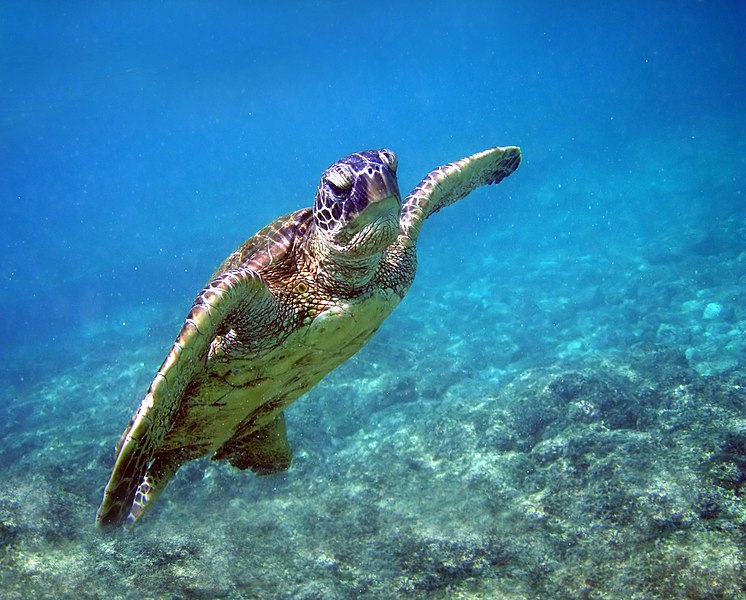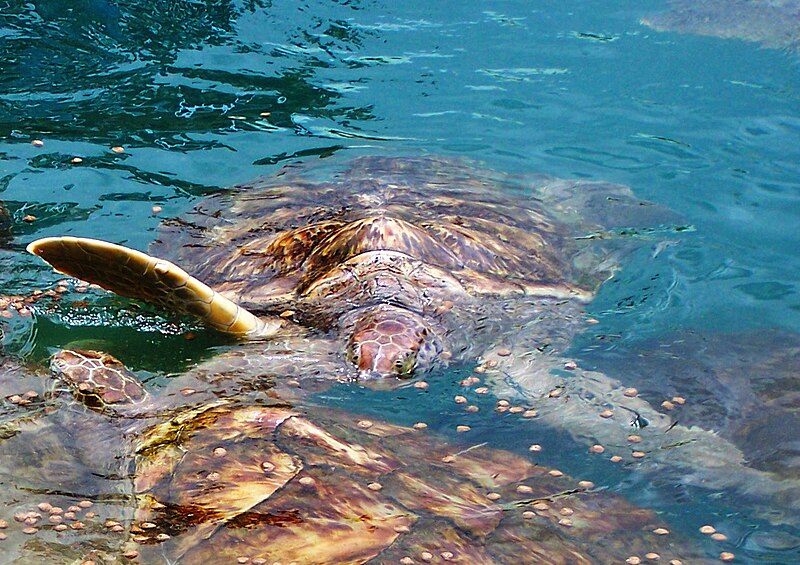 An accident that caused the deaths of 299 endangered Green Turtles at the Cayman Turtle Farm has raised concerns about the facility’s operation. The incident brought other issues to my mind as well. I was first inspired by the legendary herpetologist Archie Carr, and have since been involved in several field studies of Green, Leatherback and other marine turtles (please see article below). I see the value in organizations such as Cayman Turtle Farm, which raises turtles for the food market while also racking up important “firsts” in breeding and research. However, many disagree with me. What’s your opinion? Any comments you may wish to post below would be much appreciated.
An accident that caused the deaths of 299 endangered Green Turtles at the Cayman Turtle Farm has raised concerns about the facility’s operation. The incident brought other issues to my mind as well. I was first inspired by the legendary herpetologist Archie Carr, and have since been involved in several field studies of Green, Leatherback and other marine turtles (please see article below). I see the value in organizations such as Cayman Turtle Farm, which raises turtles for the food market while also racking up important “firsts” in breeding and research. However, many disagree with me. What’s your opinion? Any comments you may wish to post below would be much appreciated.
Conservation through Commercialization
Whatever your personal feelings concerning the consumption of turtles or other animals may be, it is clear that commercial farming can play a role in  conservation. The classic US example is the American Alligator. Legal protections helped, of course, but large scale breeding for the meat and hide trade made a huge difference in that species’ future.
conservation. The classic US example is the American Alligator. Legal protections helped, of course, but large scale breeding for the meat and hide trade made a huge difference in that species’ future.
More recently, the farming of Chinese Softshell Turtles has been advanced as a means to ease the “Asian Turtle Crisis” (please see article below). Herp hobbyists are now breeding species that were unknown even in zoos in years past, often eliminating the financial incentive for collecting wild specimens in the process (please see Do Reptile Hobbyists Help or Hinder Conservation?). At least one conservation organization, Wikiri, is now funding research by breeding frogs for the pet trade (please see this article).
Just last month, I had the thrilling opportunity to meet Jack Rudloe, a legendary naturalist whose work has influenced me since childhood. We spoke about “practical conservation” and, while there are many gray areas, it is clear to me that we cannot operate in a vacuum when the needs of people and animals collide. If this subject interests you, I highly recommend his Time of the Turtle, which combines fact, observations and a premier conservationist’s thoughts in the style of Ditmars, Pritchard and other greats…a rare treat. The Sea Brings Forth and his other books are also unequalled…you’ll not be disappointed!
Turtle Deaths at Cayman Turtle Farm

While the Cayman Turtle Farm has an impressive conservation record, its operation has not been problem-free. An attempt to ship live Green Turtles to Europe was in violation of CITES regulations, and waves from a 2001 hurricane released 75% of the farm’s breeding stock.
In a press release, Cayman Turtle Farms stated that new safeguards, including a backup water supply, have been installed.
Conservation at Cayman Turtle Farm
 Founded in 1968, the Cayman Turtle Farm is the island’s largest land-based tourist attraction. It was originally conceived as a means of producing Green Turtle meat via breeding as opposed to hunting. Over time, a significant research/conservation component was added. Turtles hatched at the farm mated and nested in 1975, a first time event that has not been accomplished elsewhere.
Founded in 1968, the Cayman Turtle Farm is the island’s largest land-based tourist attraction. It was originally conceived as a means of producing Green Turtle meat via breeding as opposed to hunting. Over time, a significant research/conservation component was added. Turtles hatched at the farm mated and nested in 1975, a first time event that has not been accomplished elsewhere.
In 1980, a breeding program was undertaken to further the conservation of the Kemp’s Ridley Turtle. In 1984, the farm became the only facility to have bred this highly endangered reptile in captivity.
Second generation Green Turtle hatchlings were produced in 1989, and to date 31,000 have been released in conjunction with a “head-starting” effort. This year (2012), a second generation Green Turtle was released and is being monitored via satellite tag. This study, the only one of its kind, may provide important information on the adaptations of captive-bred turtles to the wild. Given marine turtles’ extensive travels and complex mating strategies, herpetologists are very interested in the outcome. You can follow this turtle, known as “Jerry”, here.
Further Reading
Tagging Green Turtles in Costa Rica
Time of the Turtle, by Jack Rudloe: (reviews)
Cayman Turtle Farm Conservation Programs
News Report and Turtle Farm Statement
Green Sea Turtle image referenced from wikipedia and originally posted by Brocken Inaglory
Green Sea Turtle Farm image referenced from wikipedia and originally posted by Burtonpe
Green Sea Turtle Feeding image referenced from wikipedia and originally posted by Lhb1239
Chinese Softshell Turtle Farm image referenced from wikipedia and originally posted by Clunio
 That Reptile Blog – Reptile, Amphibian and Exotic Pet Care and Information
That Reptile Blog – Reptile, Amphibian and Exotic Pet Care and Information



thanks for the informative blog. This issue really touches my heart. I am a novice at environmental studies (with only a few college courses under my belt), however, I lack the naivety of companies with a facade of good intentions. I think it is terrible that the issue was not resolved or foreseen as these are very amazing creatures.
Hello Ariel,
Thanks for the kind words. It appears that the problem which led to the deaths has been resolved. I’ll post updates., Best., Frank
Hello Mr. Indiviglio,
I have now successfully moved to MD, just outside of Baltimore. Do you know of any turtle or reptile rescues and such that might have Muskies aound here? I’m hell-bent on rescuing one and I’ll only buy one from online as a last resort.
I’ve even been scouring craigslist for the past week and I’ve only found one there but he was too far south. Thanks!
Cheers, Alex
Hi Alex,
The Mid-Atlantic Turtle/Tort Society is based in MD and a very good resource. They have an adoption service, and should be able to help.
Enjoy, pl keep me posted, Frank
Oh yes, I’ve checked with them many times. As of yet they still don’t have any. Today though a friend of mine gave me what would be a 3 or 4 foot Northern Pine Snake. He seems fairly tame, except for hissing a bit when held. Would you have any info on these guys? I appreciate your tolerance of all my antics!
Also, it turns out that Dumeril’s really are snake eaters as he bit the Pine while I was moving them around. Either that or he’s really friendly to people, but aggressive towards other snakes as I had just fed him prior to the bite.
Cheers, Alex
Hi Alex,
Mid-Atlantic is the best known local turtle society…I don’t believe musk turtles commonly appear as animals in need of placement; not often kept, other than by people interested in the family.
Pine Snake care is similar to that of the Black Rat Snake; please see this article for details and let me know if you need any more info. A partially-buried hide box is favored by some, as they are burrowers, but not strictly necessary. You might also enjoy this on the natural history of the Black Pine Snake, the rarest species.
Most snakes will bite at others when disturbed – the scent/sight of an intruder is cause for alarm. Best not to mix snakes from different parts of the world, even briefly. parasites/bacteria that are relatively harmless to one can be fatal to others (similar to tourists getting sick after drinking tap water in foreign countries).
Best, Frank
I’ve known first hand about the foreign water part, many times in fact! I don’t even know how they got close to each other as they were in seperate bins. It seemed less of a general bite and more of an actually predation since she coiled around the Pine and I had to try hard to remove her. The only other time I’ve seen this was with Kings (Both colubrids and elapids) eating other snakes.
Thanks for the info!
Cheers, Alex
Interesting observation Alex, thanks. Could be – quite a few snakes prey on others on occasion, more than originally believed. I often come across surprising notes on this in the Natural History section of Herpetological Review. Please keep me posted, Best, Frank